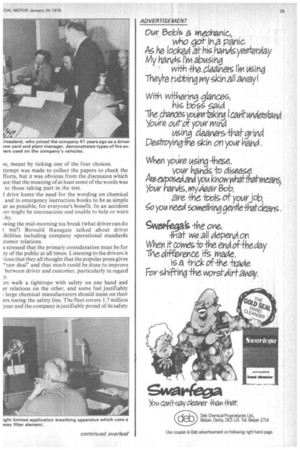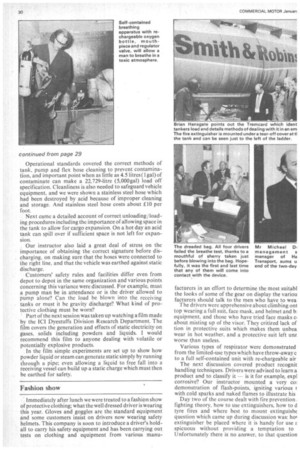Training the tanker men
Page 30

Page 31

Page 32

Page 33

If you've noticed an error in this article please click here to report it so we can fix it.
Operational efficiency and public safety go hand-in-hand in the hazardous-loads business, and both benefit from thorough driver training by Gordon Murray photographs by Harry Roberts
GOOD TRAINING is a vital part of driver education and responsible operators must feel justified in paying a great deal of attention to its development. However, uplifting the standards of the industry cannot be left entirely to the operator; the customers must be prepared to pay more than lip service to the need for better training and higher standards.
Road haulage has always been a competitive business, and the legitimate operator who provides decent facilities and introduces training schemes perhaps pays an initial penalty in increased overheads. There are always pirate operators who, free from large overheads and untroubled by conscience, are able and willing to cut rates in order to obtain work. These are the people who bring the rest of the industry into disrepute.
Their customers, many of them respected household names with high safety standards within their own organizations, are also calling for higher standards of safety from road hauliers, and quite rightly so. But at the same time they are prepared to employ the rate-cutters to move their products when it suits them to do so.
Some of the larger chemical companies already ask that operators working for them sign a declaration of their fitness to carry out the work, but apparently no attempt is .made to verify that this is in fact so.
The bulk freight tank operator in particular has been prey to these double standards for many years, as some chemical products manufacturers have traditionally played one haulier against another.
There is pressure for reputable operators and the R H A to put their case to the Chemical Industries Association, but in the meantime many companies are investing heavily in training schemes designed to raise their standards.
Hargreaves Transport (Smith and Robinson) Ltd, Rothwell, near Leeds, is one of the country's largest independent bulk liquid hauliers and provides a nationwide and Continental service from Rothwell and strategically placed depots in Stockton, Brigg, Manchester, London and Cardiff. The company's senior executive, Mr A. P. Mansfield, who is chairman of the R HA bulk liquids functional group, holds strong views about the benefits of a proper training scheme in all spheres and at all levels within the company. CM was recently invited to sit in on one of the training courses at Rothwell to see at first hand the reactions of drivers on the course.
This particular two-day programme covered the conveyance by road of hazardous chemicals, and the four men on the course were all old hands with an average of 23 years' experience of tanker driving.
The course's objective is to increase driver comprehe of the chemical loads he carries and as such is desigt appeal to practical drivers. A refreshing aspect wa amount of cross-talk about day-to-day operation I went on between the men and instructor Bernard Han: who first joined the company as a driver in 1957.
Interchange of ideas
Coincidentally, the course also serves another I function. It gives drivers the opportunity to talk abou jobs and discuss their problems with management st. their own level, and a useful interchange of ideas inva takes place. The first session, of the course which is Ri approved, consisted of a brief introduction coverir objectives of the course. This was followed -by " inology", which included a description of the Treni system and the use of emergency procedure ma approved by the Chemical Industries Association (C Before the talk on commonly used technical term their meanings the drivers were given a written pape 13-word questions, each of which had four possible an The men were asked to indicate what the words, ' included evolution, inert, miscible, viscous, aqueou in, meant by ticking one of the four choices. ttempt was made to collect the papers to check the fforts, but it was obvious from the discussion which ace that the meaning of at least some of the words was to those taking part in the test.
drive home the need for the wording on chemical and in emergency instruction books to be as simple ar as possible, for everyone's benefit. In an accident ver might be unconscious and unable to help or warn -by.
Iwing the mid-morning tea break (what driver can do t tea?) Bernal-d Hansgate talked about driver ;ibilities including company operational standards ;tomer relations, s stressed that the primary consideration must be for ty of the public at all times. Listening to the drivers it /ious that they all thought that the popular press gives "raw deal" and that much could be done to improve between driver and customer, particularly in regard .y.
rs walk a tightrope with safety on one hand and er relations on the other, and some feel justifiably large chemical manufacturers should insist on their ers toeing the safety line. The fleet covers 1.7 million year and the company is justifiably proud of its safety Operational standards covered the correct methods of tank, pump and flex hose cleaning to prevent contamination, and important point when as little as 4.5 litres (1 gal) of contaminate can make a 22,729-litre (5,000gal) load off specification. Cleanliness is also needed to safeguard vehicle equipment, and we were shown a stainless steel hose which had been destroyed by acid because of improper cleaning and storage. And stainless steel hose costs about £110 per foot.
Next came a detailed account of correct unloading/loading procedures including the importance of allowing space in the tank to allow for cargo expansion. On a hot day an acid tank can spill over if sufficient space is not left for expansion.
Our instructor also laid a great deal of stress on the importance of obtaining the correct signature before discharging, on making sure that the hoses were connected to the right line, and that the vehicle was earthed against static discharge.
Customers' safety rules and facilities differ even from depot to depot in the same organization and various points concerning this variance were discussed. For example, must a pump man be in attendance or is the driver allowed to pump alone? Can the load be blown into the receiving tanks or must it be gravity discharge? What kind of protective clothing must be worn?
Part of the next session was taken up watching a film made by the ICI Dyestuffs Division Research Department. The film covers the generation and effects of static electricity on gases, solids including powders and liquids. I would recommend this film to anyone dealing with volatile or potentially explosive products.
In the film simple experiments are set up to show how powder liquid or steam can generate static simply by running through a pipe; even allowing a liquid to free fall into a receiving vessel can build up a static charge which must then be earthed for safety.
Fashion show
Immediately after lunch we were treated to a fashion show of protective clothing; what the well dressed driver is wearing this year. Gloves and goggles are the standard equipment and some customers insist on drivers now wearing safety helmets. This company is soon to introduce a driver's holdall to carry his safety equipment and has been carrying out tests on clothing and equipment from various manu facturers in an effort to determine the most suitabl the looks of some of the gear on display the variou facturers should talk to the men who have to wea The drivers were apprehensive about climbing oni top wearing a full suit, face mask, and helmet and b. equipment, and those who have tried face masks c, about misting up of the visor, They critized lack of tion in protective suits which makes them unbea wear in hot weather, and a protective suit left unz worse than useless.
Various types of respirator were demonstrated from the limited-use types which have throw-away c to a full self-contained unit with re-chargeable air The next discussion covered product recognit handling techniques. Drivers were advised to learn a product and to classify it — is it for example, expl corrosive? Our instructor mounted a very col demonstration of flash-points, igniting various r with cold sparks and naked flames to illustrate his Day two of the course dealt with fire preVention • fighting theory, how to use extinguishers, how to d tyre fires and where best to mount extinguishe question which came up during discussion was: hol extinguisher be placed where it is handy for use spicuous without providing a temptation to Unfortunately there is no answer, to that question istructor, Mr C. Crossland, said all a company can ke sure that it has the best equipment; in the event of driver is on his own for at least the first few minutes. nents for and against the mounting of extinguishers , rear and sides of the tank were put forward. fly it was decided that all have distinct advantages, hoped to standardize on mounting positions for all in the fleet.
mers disagree with one another over the type of fire equipment they require hauliers to carry, and one r in particular has still not made up his mind after a half years.
:.mainder of this two-day course covered emergency res and detailed the action taken by public ies in the event of a chemical tanker accident. were instructed in the operation of the ICI GI which covers the UK. Providing technical advice and :nt in an emergency.
I game ourse wound up with a hazard game, a simulated • and delivery with a number of deliberate mistakes which had been covered previously on the course. came the dreaded breath test; fortunately it was )ut by Bernard Hansgate rather than by the police — we all failed. Not because of heavy drinking at le, I might add, but simply through holding a il of sherry for several seconds, which demonstrated itivity of the little crystals to alcohol.
:ourse was summed up by Mr Michael Dugmore, yes Transport management services manager, but the last word should ,come from Mr A. P. Mans io said: feel that the company's safety record is a e; nevertheless with this and other courses we run we ig to make it better. We should be concerned about 'dards and we should be seen to be concerned."




































































































